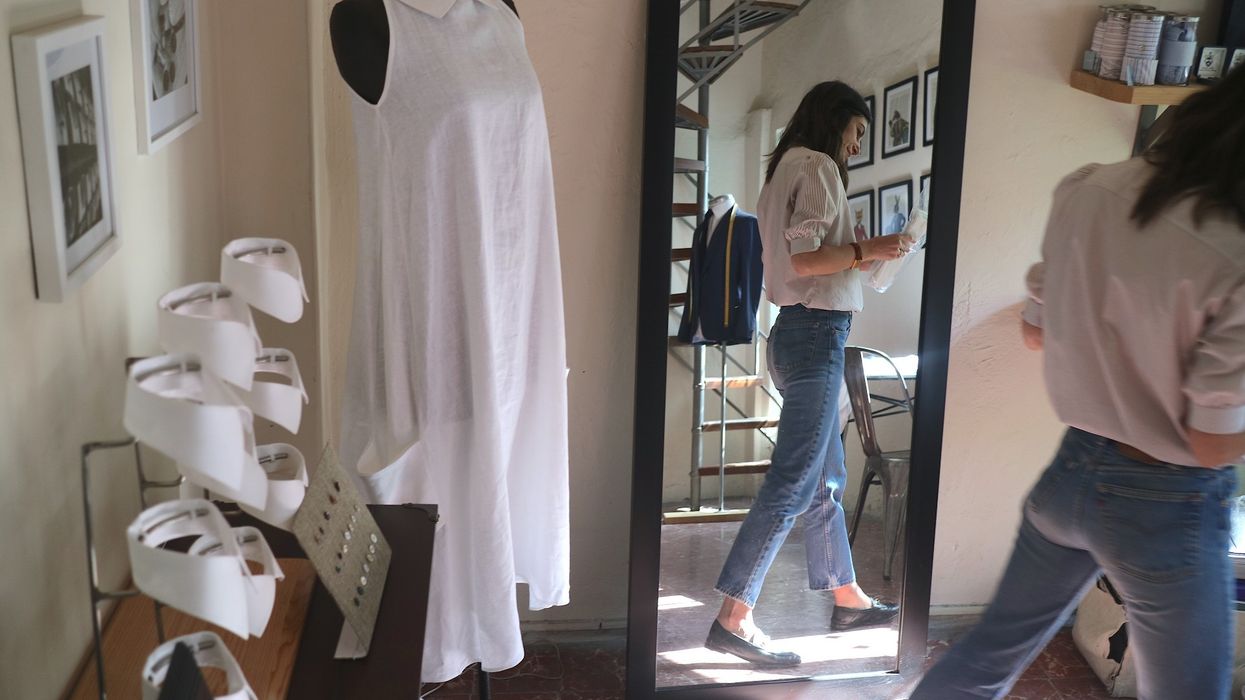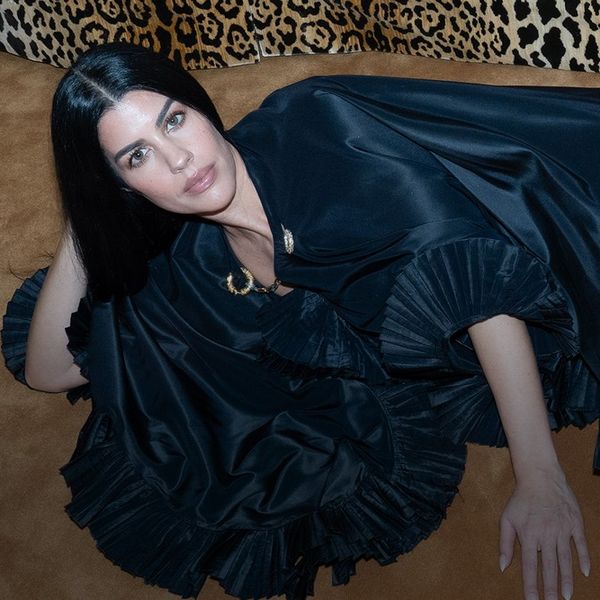This Mexico City Custom Shirting Studio Likes to Get Creative with Cuffs
And collars, yokes, tie gaps, and more.

“I think French cuffs are so chic, especially if you're not wearing them without cufflinks, you're just letting them fly in the wind,” says Chava Studio’s Olivia Villanti, her eyes alight as she muses. “Or you have this great cool cuff that, when you roll the sleeve, you can create something really beautiful.” Bring up any shirting detail, be that a French cuff, a spread collar, or a tuxedo bib, and you’ll lose Villanti’s attention for a minute as she ponders their wonders. “I think shirting is the ultimate device for deliberate details,” she summarizes. “There's 50 gazillion ways that you can play with a collar. And there's a million different ways that you can play with a cuff.”
And play, she does. Villanti is the founder of Chava Studio, a Mexico City-based studio that specializes in custom shirting. “I take a lot [of inspiration] from traditional men's tailoring, but it's never taken at face value,” she says though the realms of vintage, women’s, even children’s shirting are by no means off limits. Take, for instance, the brand’s elegant white shirt, which Villanti says is the most direct interpretation of a pre-existing silhouette. It has collar stays, a split-yoke, a cutaway collar, even a tie gap—oh my!— all of which are traditional elements of men’s shirting (and terms I had to google). Men’s shirts are traditionally broader in the chest, but narrower in the hips. In some designs, she flips the dimensions, but here they remain—and always oversized. Villanti picked a silky cotton with just a slight feminine sheen. “And then we really made the collar nice and short. Not too short, but short enough that if you were to pop your collar, you're not going to have too much collar coming up into your face.” Like I said, the attention to detail is evident.
Villanti’s shirting endeavor benefitted from pre-existing infrastructure. Her husband, Guillaume Guevara’s family have been importing fine fabrics to Mexico City from Europe for decades. In more recent years, her uncle expanded the venture to include a made-to-measure shirting studio roughly eight years ago. When the couple relocated to Mexico City in 2019, Villanti began working with them to make shirts for herself—and the spark was lit. She capitalized on the employees and know-how to translate these concepts into fresh designs for women. (Chava is slang for a young woman). She began Chava Studio as a small online business in 2020—but the project called for a more physical element.
The space itself she updated, as well. The studio originally served as a vecindad, a type of tenement housing popularized in Mexico in the 20th century. “It felt very preserved and old school—a time when men had all of their shirts made, which is still a reality in Mexico. There are still a lot of independently run tailors that you could go to, which is a beautiful thing about Mexico.” Architect Diego Villaseñor, a student of legendary architect Luis Barragán, bought the building and renovated it for his first offices some time in the early '80s. (Barragán’s famous residence is just down the street). Guevara’s family bought it in 1990. “You kind of feel like you travel back in time when you come to the studio,” says Villanti.
She began renting her showroom, which had previously served as a storage closet, from her uncle in 2020. “It didn't really have much of an identity or a personality,” she recounts. Old carpet, crumbling ceiling—the works. Refurbishment was due. Six months later, she enlisted architect Diego Solares to help the space to “feel a little more Chava,” she explains. “It was really just about incorporating a lot of natural elements.” They added concrete walls in lieu of the pre existing sheetrock, exposed a brick wall, boarded up the ceiling with plywood—”it feels like you're in this nice little cave.” The floor is now coated in old tilework and the entryway expanded. The walls still reflect the family’s history—a different uncle’s mask collection amassed from traveling throughout Mexico hangs proudly on a blue facade.
Upon its completion in July 2021, the studio was open for appointments—this in-person element is the core of her brand. Now samples hang from old railings. Starched collars perch on a table, seducing prospective customers to discover more of the shirting lore. Measurements litter the chalkboards, or “communal note board,” as Villanti calls them.
Evident in the arrangement, all the shirt-building happens onsite. Villanti employs a team of four and has cultivated a deep relationship with her seamstresses. (They outsource experts for suiting and hair accessories.) “I'm super involved with production,” she explains. “I'm super involved with our grading, with our patterns. Everyday, I'm here at the studio and I'm working with our seamstresses,” she says. “I never really knew that you could have that level of closeness, one, with your production, and two, that you could create products that just felt so unique and special.”
Though she launched Chava in 2020, her love of fashion dates back decades. Villanti worked in New York’s fashion and editorial spheres for decades, with stints at Madewell, Lucky Magazine, and more. The constant churn of product had her disillusioned with the world of fashion. She says she didn’t have “a relationship” with her clothes, at that point, despite their weighty presence in her life and career. Vintage was the only thing that could still light her up. When the pair moved to Mexico City, she had no desire to continue working in fashion.
“I guess it kind of revived me,” she says of the very tangible process of conception, production, and final product. She got the “special”-ness back. “I design for myself in a lot of ways,” she says, sitting before me in a white Chava Studio shirt (Villanti wears a Chava shirt nearly everyday).Everything she does with her personal money, no investors—a sort of blessing in disguise. The made-to-order element is conducive with the lifestyle of the city. “I don't have the demands to create things that I don't love. So if I don't love it, I'm just not going to make it.” That’s also how she justifies the sampling process. If no one buys it, at least it has a home in her closet. “I also feel like it's helped me establish my own personal style in a different way too,” she continues. “It's made me super opinionated about fit and about fabric.”
Now, it would pain her to do anything else. “If you're cynical and feeling a little jaded, there's really nothing like [it],” she says, “seeing ideas come to life or having an amazing dialogue with a client about a shirt that means so much to them.”
Want more stories like this?
The Founders of Interior Are Masters of Earnest Angst
Craftsmanship Reigns Supreme in This Meticulous Mexico City Atelier
Cecilie Bahnsen's Copenhagen Office Embodies Scandinavian Minimalism




